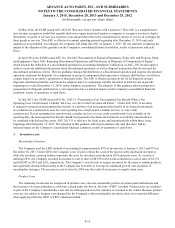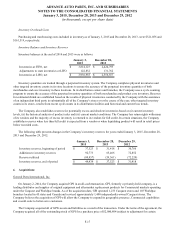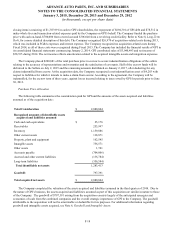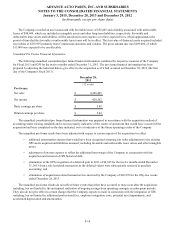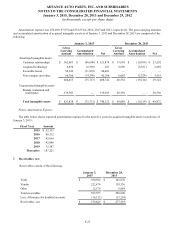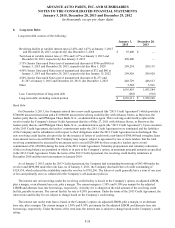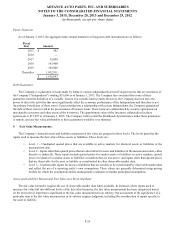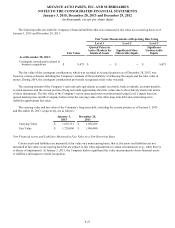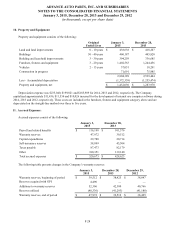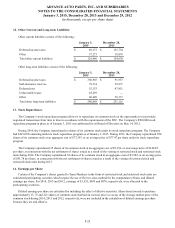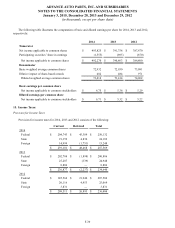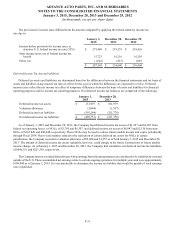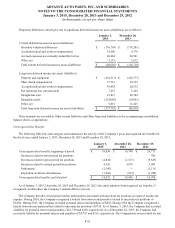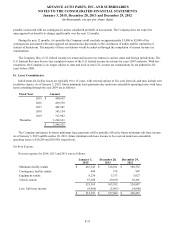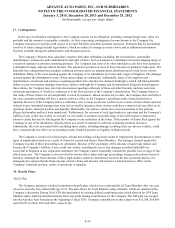Advance Auto Parts 2014 Annual Report Download - page 73
Download and view the complete annual report
Please find page 73 of the 2014 Advance Auto Parts annual report below. You can navigate through the pages in the report by either clicking on the pages listed below, or by using the keyword search tool below to find specific information within the annual report.
ADVANCE AUTO PARTS, INC. AND SUBSIDIARIES
NOTES TO THE CONSOLIDATED FINANCIAL STATEMENTS
January 3, 2015, December 28, 2013 and December 29, 2012
(in thousands, except per share data)
F-26
Future Payments
As of January 3, 2015, the aggregate future annual maturities of long-term debt instruments are as follows:
Fiscal
Year Amount
2015 $ 582
2016 —
2017 35,000
2018 163,400
2019 385,000
Thereafter 1,052,911
$ 1,636,893
Debt Guarantees
The Company is a guarantor of loans made by banks to various independently-owned Carquest stores that are customers of
the Company ("Independents") totaling $33,606 as of January 3, 2015. The Company has concluded that some of these
guarantees meet the definition of a variable interest in a variable interest entity. However, the Company does not have the
power to direct the activities that most significantly affect the economic performance of the Independents and therefore is not
the primary beneficiary of these stores. Upon entering into a relationship with certain Independents, the Company guaranteed
the debt of those stores to aid in the procurement of business loans. These loans are collateralized by security agreements on
merchandise inventory and other assets of the borrowers. The approximate value of the inventory collateralized in these
agreements is $71,997 as of January 3, 2015. The Company believes that the likelihood of performance under these guarantees
is remote, and any fair value attributable to these guarantees would be very minimal.
9. Fair Value Measurements:
The Company’s financial assets and liabilities measured at fair value are grouped in three levels. The levels prioritize the
inputs used to measure the fair value of these assets or liabilities. These levels are:
• Level 1 – Unadjusted quoted prices that are available in active markets for identical assets or liabilities at the
measurement date.
• Level 2 – Inputs other than quoted prices that are observable for assets and liabilities at the measurement date, either
directly or indirectly. These inputs include quoted prices for similar assets or liabilities in active markets, quoted
prices for identical or similar assets or liabilities in markets that are less active, and inputs other than quoted prices
that are observable for the asset or liability or corroborated by other observable market data.
• Level 3 – Unobservable inputs for assets or liabilities that are not able to be corroborated by observable market data
and reflect the use of a reporting entity’s own assumptions. These values are generally determined using pricing
models for which the assumptions utilize management’s estimates of market participant assumptions.
Assets and Liabilities Measured at Fair Value on a Recurring Basis
The fair value hierarchy requires the use of observable market data when available. In instances where inputs used to
measure fair value fall into different levels of the fair value hierarchy, the fair value measurement has been categorized based
on the lowest level input that is significant to the fair value measurement in its entirety. Our assessment of the significance of a
particular item to the fair value measurement in its entirety requires judgment, including the consideration of inputs specific to
the asset or liability.


